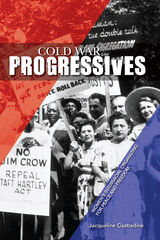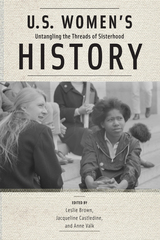2 books about Castledine, Jacqueline

Cold War Progressives
Women's Interracial Organizing for Peace and Freedom
Jacqueline Castledine
University of Illinois Press, 2012
In recognizing the relation between gender, race, and class oppression, American women of the postwar Progressive Party made the claim that peace required not merely the absence of violence, but also the presence of social and political equality. For progressive women, peace was the essential thread that connected the various aspects of their activist agendas. This study maps the routes taken by postwar popular front women activists into peace and freedom movements of the 1960s and 1970s. Historian Jacqueline Castledine tells the story of their decades-long effort to keep their intertwined social and political causes from unraveling and to maintain the connections among peace, feminism, and racial equality.
Postwar progressive women and their allies often saw themselves as members of a popular front promoting the rights of workers, women, and African Americans under the banner of peace. However, the Cold War indelibly shaped the contours of their activism. Following the Progressive Party's demise in the 1950s, these activists reentered social and political movements in the early 1960s and met the inescapable reality that their agenda was a casualty of the left-liberal political division of the early Cold War era. Many Americans now viewed peace as a leftist concern associated with Soviet sympathizers and civil rights as the favored cause of liberals. Faced with the dilemma of working to reunite these movements or choosing between them, some progressive women chose to lead such New Left organizations as the Jeannette Rankin Brigade while others became leaders of liberal "second wave" feminist movements.
Whether they committed to affiliating with groups that emphasized one issue over others or attempted to found groups with broad popular-front type agendas, Progressive women brought to their later work an understanding of how race, class, and gender intersect in women's organizing. These women's stories demonstrate that the ultimate result of Cold War-era McCarthyism was not the defeat of women's activism, but rather its reconfiguration.
[more]

U.S. Women's History
Untangling the Threads of Sisterhood
Brown, Leslie
Rutgers University Press, 2017
In the 1970s, feminist slogans proclaimed “Sisterhood is powerful,” and women’s historians searched through the historical archives to recover stories of solidarity and sisterhood. However, as feminist scholars have started taking a more intersectional approach—acknowledging that no woman is simply defined by her gender and that affiliations like race, class, and sexual identity are often equally powerful—women’s historians have begun to offer more varied and nuanced narratives.
The ten original essays in U.S. Women's History represent a cross-section of current research in the field. Including work from both emerging and established scholars, this collection employs innovative approaches to study both the causes that have united American women and the conflicts that have divided them. Some essays uncover little-known aspects of women’s history, while others offer a fresh take on familiar events and figures, from Rosa Parks to Take Back the Night marches.
Spanning the antebellum era to the present day, these essays vividly convey the long histories and ongoing relevance of topics ranging from women’s immigration to incarceration, from acts of cross-dressing to the activism of feminist mothers. This volume thus not only untangles the threads of the sisterhood mythos, it weaves them into a multi-textured and multi-hued tapestry that reflects the breadth and diversity of U.S. women’s history.
[more]
READERS
Browse our collection.
PUBLISHERS
See BiblioVault's publisher services.
STUDENT SERVICES
Files for college accessibility offices.
UChicago Accessibility Resources
home | accessibility | search | about | contact us
BiblioVault ® 2001 - 2024
The University of Chicago Press









